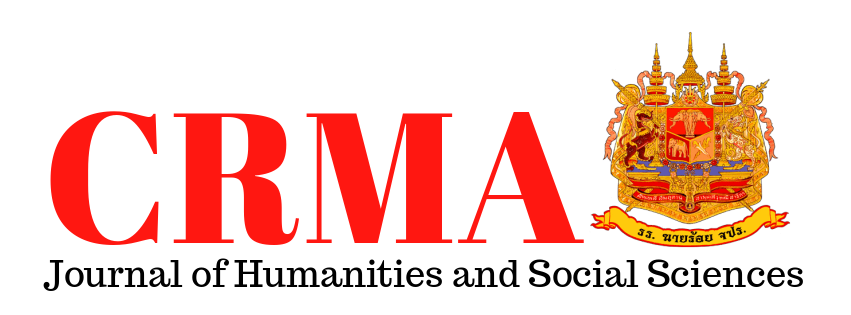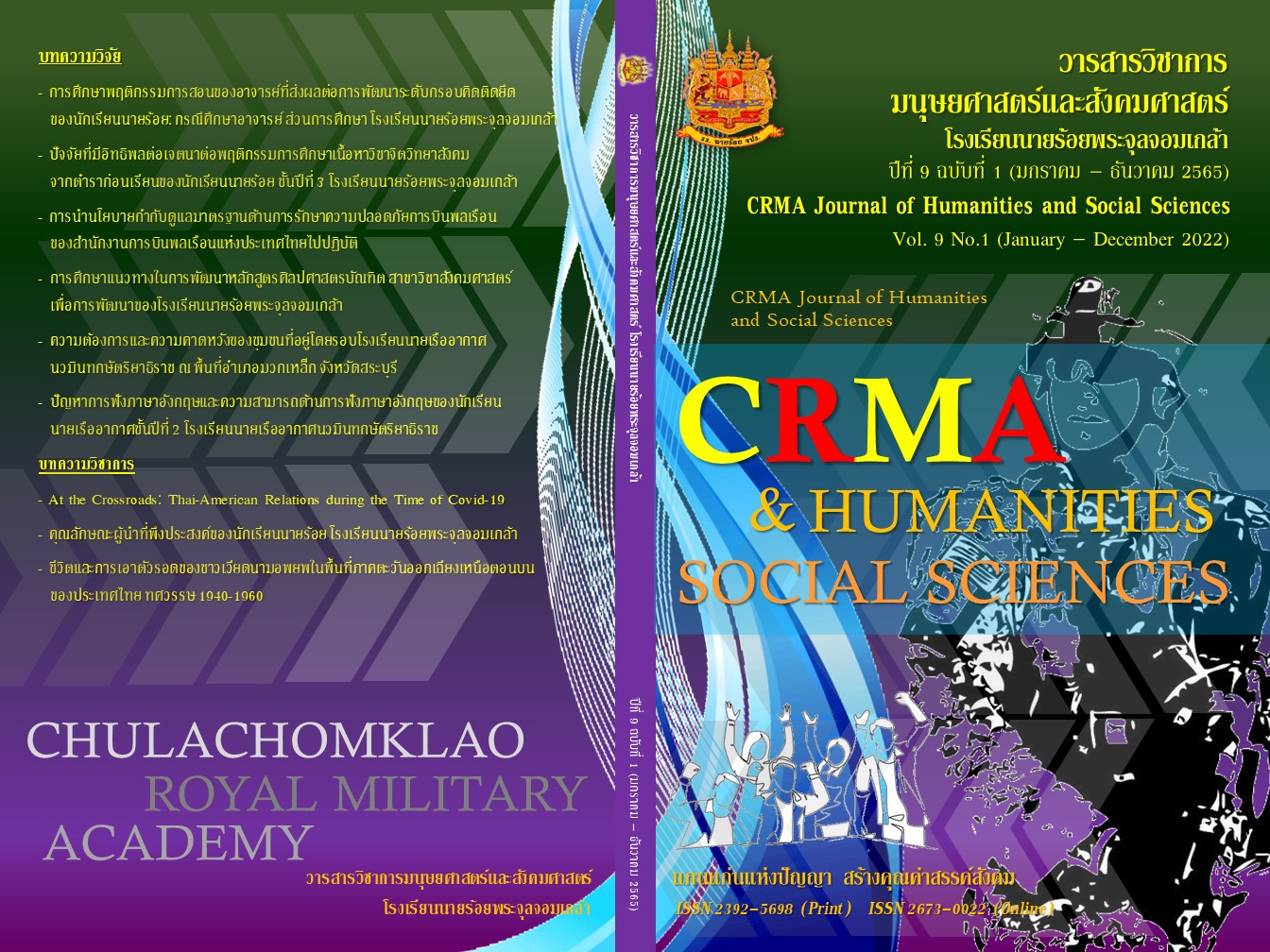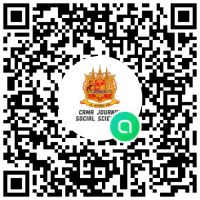การศึกษาแนวทางในการพัฒนาหลักสูตรศิลปศาสตรบัณฑิต สาขาวิชาสังคมศาสตร์เพื่อการพัฒนาของโรงเรียนนายร้อยพระจุลจอมเกล้า
คำสำคัญ:
การพัฒนาหลักสูตรศิลปศาสตรบัณฑิต , สาขาวิชาสังคมศาสตร์เพื่อการพัฒนา , โรงเรียนนายร้อยพระจุลจอมเกล้าบทคัดย่อ
งานวิจัยฉบับนี้มีวัตถุประสงค์ 2 ประการ คือ 1) เพื่อศึกษาข้อมูลพื้นฐานในการพัฒนาหลักสูตรศิลปศาสตรบัณฑิต สาขาวิชาสังคมศาสตร์เพื่อการพัฒนา และ 2) เพื่อเสนอแนวทางในการพัฒนาหลักสูตรฯ ให้มีคุณภาพตามมาตรฐานของสำนักงานคณะกรรมการการอุดมศึกษา และสอดคล้องกับความต้องการของหน่วยใช้งานของกองทัพบก ซึ่งใช้แนวคิดการพัฒนาหลักสูตรและใช้ระเบียบวิธีวิจัยเชิงคุณภาพ ดำเนินการเก็บข้อมูลจากแบบสัมภาษณ์ โดยวิธีการสัมภาษณ์แบบเจาะลึกและการสัมภาษณ์เชิงกลุ่ม จากผู้สำเร็จการศึกษาจากโรงเรียนนายร้อยพระจุลจอมเกล้า พร้อมทั้งผู้บังคับบัญชาและผู้ใต้บังคับบัญชา ตลอดจนการสัมมนาอาจารย์ผู้รับผิดชอบรายวิชาของหลักสูตร และใช้การวิเคราะห์เนื้อหาในการวิเคราะห์ข้อมูล
ผลการวิจัยในส่วนของข้อมูลพื้นฐานเพื่อพิจารณาปรับปรุงหลักสูตร พบว่า 1) การปฏิบัติตามกรอบภารกิจของกองทัพบก ปัจจุบันมีบทบาทหน้าที่เปลี่ยนไปตามพลวัตทางสังคม หน่วยใช้มีความต้องการนายทหารสัญญาบัตร (หลัก) ที่มีความรู้และทักษะที่สอดคล้องกับภารกิจ สามารถพัฒนาตนเองตามบริบททางสังคมและค่าครองชีพได้ 2) หลักสูตรฯ ต้องไม่มุ่งเพียงเฉพาะเนื้อหา หากต้องมีกิจกรรมการเรียนรู้ในการประยุกต์ใช้องค์ความรู้ตามสถานการณ์จริง 3) หลักสูตรฯ ต้องมีการปรับเปลี่ยนสาระการเรียนรู้ให้สอดคล้องกับการเปลี่ยนแปลงทางสังคม เน้นการเรียนรู้แบบบูรณาการเพื่อสร้างกระบวนทัศน์การพัฒนา ทั้งนี้ ในส่วนของแนวทางการพัฒนาหลักสูตร พบว่า ควรมีการปรับปรุงตามองค์ประกอบของหลักสูตรทุกด้าน โดยการพิจารณาใช้ผลการวิจัยในส่วนแรกเป็นกรอบในการพัฒนา เพื่อสร้างและฝึกฝนให้เกิดกระบวนการเรียนรู้ในลักษณะการบูรณาการองค์ความรู้ตามสหวิทยาการที่ทันสมัยเชื่อมโยงกับกระบวนทัศน์ในการพัฒนา การมีคุณธรรม จริยธรรม และภารกิจทางทหารอย่างเป็นรูปธรรม
เอกสารอ้างอิง
กองทัพบก. (2565, 20 กรกฎาคม). ภารกิจและภารกิจกองทัพบก. https://rta.mi.th/
ดนุลดา จามจุรี. (2563). การออกแบบการเรียนรู้สำหรับผู้เรียน Gen Z. บัณฑิตวิทยาลัย มหาวิทยาลัยศรีนครินทรวิโรฒ.
ทิศนา แขมมณี. (2556). รูปแบบการเรียนการสอน: ทางเลือกที่หลากหลาย (พิมพ์ครั้งที่ 8). แอคทีฟ พรินท์.
พิมพันธ์ เตชะคุปต์. (2563). การเรียนรู้เชิงรุกแบบรวมพลังกับ PLC เพื่อการพัฒนา (พิมพ์ครั้งที่ 4). สำนักพิมพ์จุฬาลงกรณ์มหาวิทยาลัย.
มนันยา สายชู. (2563). การวิเคราะห์การออกแบบหลักสูตรสถานศึกษาขั้นพื้นฐานจากวิทยานิพนธ์เกี่ยวกับการพัฒนาหลักสูตรในประเทศไทย. คณะครุศาสตร์ จุฬาลงกรณ์มหาวิทยาลัย.
วารีรัตน์ แก้วอุไร. (2564). การพัฒนาหลักสูตร: จากทฤษฎีสู่การปฏิบัติ. สำนักพิมพ์มหาวิทยาลัยนเรศวร.
วิทวัส รุ่งเรืองผล, กฤษฎารัตน์ วัฒนสุวรรณ, และสุรัตน์ ทีรฆาภิบาล. (2562). การพัฒนาหลักสูตรและแนวทางการสอนเพื่อสร้างนักการตลาดสู่ประเทศไทย 4.0. สำนักงานศูนย์วิจัยและให้คำปรึกษาแห่งมหาวิทยาลัยธรรมศาสตร์.
สรศักดิ์ งามขจรกุลกิจ. (2565). โครงการวิจัย “การออกแบบระบบการศึกษาทางทหารของไทยใหม่เพื่อการผลิตทหารอาชีพและปฏิรูปกองทัพ”. สำนักงานคณะกรรมการส่งเสริมวิทยาศาสตร์ วิจัยและนวัตกรรม.
สำนักงานสภาพัฒนาการเศรษฐกิจและสังคมแห่งชาติ. (2565, 20 กรกฎาคม). ยุทธศาสตร์ชาติด้านความมั่นคง. http://nscr.nesdc.go.th/ns
สำนักบริหารงานการมัธยมศึกษาตอนปลาย สำนักงานคณะกรรมการการศึกษาขั้นพื้นฐาน. (2565, 20 กรกฎาคม). แนวทางจัดการเรียนรู้ในศตวรรษที่ 2 21st Century Skills. https://webs.rmutl.ac.th/assets/upload/files/2016/09/20160908101755_51855.pdf
Taba, H. (1962). Curriculum Development: Theory and Practice. Harcourt Brace Jovanovich.
ดาวน์โหลด
เผยแพร่แล้ว
รูปแบบการอ้างอิง
ฉบับ
ประเภทบทความ
หมวดหมู่
สัญญาอนุญาต
ลิขสิทธิ์ (c) 2022 วารสารวิชาการมนุษยศาสตร์และสังคมศาสตร์ โรงเรียนนายร้อยพระจุลจอมเกล้า

อนุญาตภายใต้เงื่อนไข Creative Commons Attribution-NonCommercial-NoDerivatives 4.0 International License.
เนื้อหาและข้อมูลที่ตีพิมพ์ในวารสารนี้ถือเป็นข้อคิดเห็นและความรับผิดชอบของผู้เขียนบทความโดยตรงกองบรรณาธิการวารสารไม่จำเป็นต้องเห็นด้วยหรือร่วมรับผิดชอบในทุกกรณี
บทความและข้อมูลที่ได้รับการตีพิมพ์ในวารสารนี้ถือเป็นลิขสิทธิ์ของวารสารผู้ใดต้องการตีพิมพ์ซ้ำต้องได้รับอนุญาตจากบรรณาธิการวารสารก่อนเท่านั้น และบทความที่ได้รับการตอบรับเพื่อตีพิมพ์ในวารสารนี้จะต้องไม่ปรากฎในสิ่งพิมพ์อื่นใดมาก่อนที่จะปรากฎในวารสารนี้ กองบรรณาธิการจะส่งวารสารที่มีบทความของผู้เขียนตีพิมพ์ให้แก่ผู้เขียนจำนวน 1 ฉบับ







